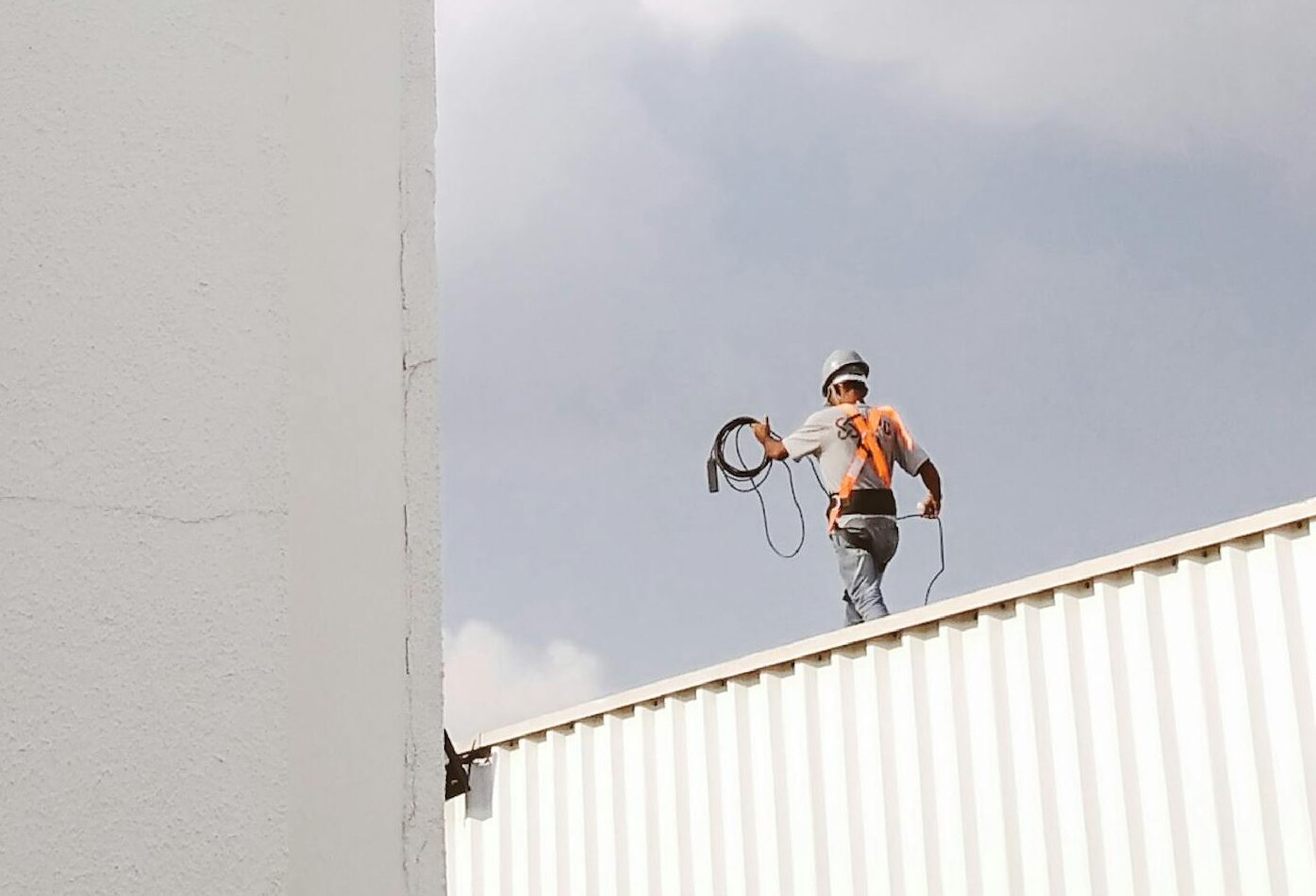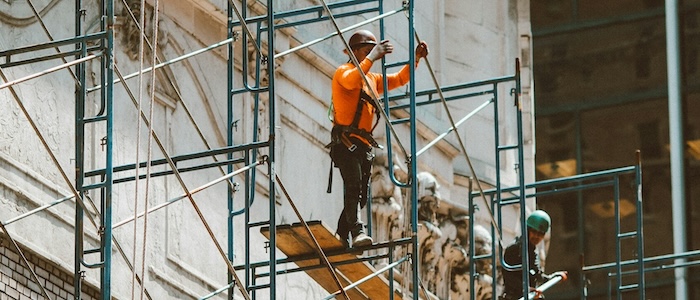Dashpivot Article – Fall Protection Equipment
Fall Protection Equipment
In this post, we’ll cover the most important aspects of fall protection equipment, and a number of solutions for companies to to reduce general fall and working at height risk.

Falls are the number one cause of death on construction sites, with 38.4% of fatalities in 2022, and many studies show that a big chunk of non-fatal injuries are falls, slips, and trips. That’s 1 in 5 workplace deaths due to fall-related accidents, and that’s scary for workers and people in the construction industry. It's for this reason, that fall protection equipment is some of the most important safety equipment for any company engaged in working at heights.
Why Do Sites Need Fall Protection Equipment?
To put it simply, fall protection is required when workers are constantly working at heights or near fall hazards that are unavoidable to prevent serious injuries and save lives that matter. As falls, slips, or trips are frequent, there are laws and safety standards that require organisations to adhere to some levels of fall protection to prevent these accidents. For example, there are OSHA requirements and standards in place so that companies in the construction industry are legally required to comply with these to better protect their workers from falls.
Using fall protection equipment also affects the company’s brand image and overall productivity as workers perform better when they experience a safer workplace. In addition, workplace accidents can cost the company financially, especially when there is downtime, legal fees, and upfront insurance costs involved.
As an added measure, keeping up with the latest safety tech solutions can also help organisations protect their workers, especially in high-risk areas, as they provide real-time updates and better documentation.
Types of Fall Protection Equipment and How to Use Them
When there is a high chance of falling or fall hazards are found on site, it is essential to ensure that fall protection is in place to better address the risks associated with it. Fall protection is categorised into three; fall guarding, arresting, and restraining, which are for specific safety purposes, and this section details these:
Fall Protection Equipment - Fall Guarding
Also known as fall protection, fall guarding is installing physical barriers to block access where hazardous areas are found. For construction sites and manufacturing plants, fall guarding is essential to ensure that workers are safe near edges or openings that are prone to falls, trips, or slips.
Guardrails and Safety Barriers: These safety equipment are installed around areas containing elevated platforms or open edges, as they prevent falls, trips, and slips from occurring.
Covers: These types of personal protective equipment are employed to cover large open floor and roof openings as well as other openings to avoid falls, and they are employed in energy plants and manufacturing facilities to prevent falling into machinery and dangerous places. The same covers are also utilised for big manufacturing facilities as well as construction sites to reduce injuries related to slips, trips, and falls.
Safety Nets: The safety nets are installed underneath construction sites or in the high-risk working areas in manufacturing units, where a falling employee, machine, or any article may enter, thereby protecting from further drops to minimise potential injury.
Fall Arrest
Fall arrest systems take place when the fall has already started to minimise the injury resulting from it, and harnesses are attached to a firm anchor point.
Full-Body Harnesses: These devices distribute the forces during a fall to the body to reduce injury risks, and they are required in any environment where falling from a high height is a great risk.
Lanyards and Lifelines: These connect the harness to the anchor point and can include shock absorbers to reduce impact forces. The lanyards and lifelines are required in high-height work situations like tower and sky-rise construction and maintenance.
Anchor Points: Anchor points are the secure locations to attach lanyards, lifelines, or other components of the fall arrest system.
Fall protection Equipment - Fall Restraint
Fall restraint systems prevent workers from reaching edges where falls can occur and are considered preventive measures. Here is some equipment to use in restraining falls in the workplace:
Work Positioning Systems: This allows workers to work in a hands-free position while being secured against falls. They are especially useful in industries like telecommunications and utility maintenance, where accuracy and precision are required.
Lanyards: They provide constant length to prohibit the worker from accessing hazardous spots and are most useful in jobs on rooftops and elevated workplaces.
Body belts or harnesses: They are typically used in conjunction with lanyards or tethers to restrain the worker from going beyond a safe space.
Anchor Points: Anchor points in fall restraint systems must be placed in a position to prevent the worker from reaching a point where a fall can occur. This means the anchor points must not only be secure but also positioned such that the tethered worker cannot reach the fall hazards.
How to Use Fall Protection Equipment Correctly
Workers are required to have training and certification to work at heights, so every worker will have some knowledge of fall protection equipment. However, when working with cross-functional teams, the individual workers will have different levels of experience. Some workers may not be updated on the latest industry equipment and best practices. It’s worth ensuring that all members of your work team are up to date with the latest training and resources. Here are some ways to use fall protection equipment correctly:
Customised Training Sessions with Real-Life Situations
Training should mimic the real workplace conditions where the activity will be performed. For example, practice using fall protection gear in confined spaces and while working from scaffolding, and have hands-on experience with the equipment the members will be using in real work situations.
Conduct Daily or Weekly Toolbox Talks About Fall Protection Equipment and Usage
Toolbox talks are a very important tool for ensuring proper fall protection practices, creating an open forum where workers can discuss real-world safety challenges and share experiences from scenarios like working over water. These daily or weekly toolbox talk sessions blend practical demonstrations of proper equipment use—from harness adjustments to anchor point selection—with powerful near-miss stories that reinforce safety protocols, while hands-on demonstrations and maintenance tips ensure workers leave with a clear understanding of their safety responsibilities and how to properly implement them on the job.
Scheduled Equipment Inspections with Checklists
It would be very helpful for an organisation to ensure a safe working environment if a scheduled inspection routine were maintained, coupled with checklists specific to the types of fall protection equipment. For example, teams that utilise fall arrest equipment should always inspect harnesses and lanyards for suspected damage due to frequent abrasion or heavy use. As with any safety procedure, such inspections need to be recorded and checked against issues and should be addressed regularly to maintain the highest degree of safety possible.
Simulate Safety Drills in the Workplace
Simulation safety drills of real-life scenarios in the workplace are also beneficial, especially if they include fall protection gear, which is utilised under supervision. This hands-on approach allows workers to understand how fall protection could be important for them in specific situations they might encounter and allows them to familiarise themselves with these issues as they arise.
Regular Fall Protection Equipment Compatibility Checks
Fall protection equipment should fit into both the task and environmental demands of the job. For instance, if fall protection is applied in a high-rise building, you and your team members should ascertain that harnesses and lanyards can be used for high-rise work and that anchor points can support loads needed for the given task. You should regularly review and update the specifications of equipment according to the respective industries' changing needs.
Job-Specific Protocols
Develop and implement job-specific protocols that address the fall hazards when performing a specific task that requires fall protection equipment. For example, fall protection equipment will need to be anchored differently on a domestic residence being constructed compared to a commercial facility being maintained.
Job-specific protocols ensure workers are not only aware of the general importance of fall protection but also know the specific practices to mitigate the risks in their work environment.
All fall protection sessions and meetings should be documented and stored for review and reuse; here’s an example of a toolbox talk on fall protection that has been recorded using a toolbox talk form:

Free and customisable forms to enhance your toolbox talks about fall protection equipment
Record your toolbox about using fall protection equipment with custom forms
Toolbox talks about how using fall protection equipment needs structure and proper documentation to be effective. This toolbox talk fall protection template has all the fields to hold a meeting on fall protection topics. You can add your notes and identify fall risks and controls, action items, and attendance all in one place, and you can also add extra fields to attach the latest fall protection safety protocols.
Final Thoughts on Fall Protection Equipment
Fall protection is not just about compliance; it’s about having a workplace where every team member feels safe and empowered to perform at their best. Fall protection measures, training, and inspection protocols will save lives and lay the foundation for operational excellence that will be the key to your organisation’s future success.
Ready to upgrade your fall protection programme? Help transform your safety management with a digital safety platform that lets you manage inspections, training, and protocols in one system. Get started today with a safety management solution that can help show you how technology can revolutionise your workplace safety.

Working at Heights Risk Assessment template
Improve working at heights safety by following and completing this working at heights risk assessment template.

Safe Work Method Statement for Working at Heights template
Reduce the likelihood and consequences associated with terrible working at heights incidents by better managing and communicating your SWMS.

JHA Roofing template
Create safe work processes by using this free JHA Roofing template for your next Roofing project.

